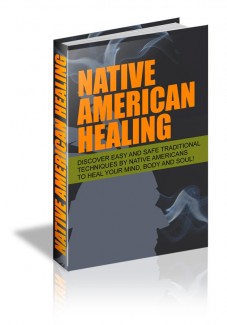 License Type: Private Label Rights
License Type: Private Label Rights  File Size: 31,053 KB
File Size: 31,053 KB File Type: ZIP
File Type: ZIP
 SKU: 53350
SKU: 53350  Shipping: Online Download
Shipping: Online Download
Ebook Sample Content Preview:
Chapter 8: Healing Herbs
Synopsis
Because of Native Americans' intimate relationship with nature, a lot of therapies emphasize plants' mind-body-spirit healing potential.
Plant Life
Native-American herbalism is much more composite than herbs merely serving as a plant matrix to deliver physiologically active chemicals.
First of all, because numerous plant elements affect bodily functions and bioavailability, the total remedy is considered the active agent.
Secondly, as plants are believed to possess spirit and intelligence, they're conferred with to determine their best healing relationship with patients, and permission is obtained prior to and gratitude expressed following harvesting them.
Thirdly, involved procedures are utilized to harvest herbs, considering factors like plant part (e.g., flower, stem, root, and so forth), time or season of harvest, sun exposure, and a great deal more obscure factors.
Fourthly, native herbalists utilize plants that come up in dreams, a form of communication by which the plant's spirit may guide the healer.
Lastly, the plant's healing potency is empowered by ritual ceremony, prayer, song, or chants.
Chapter 9: Medicine Wheel
Synopsis
The medicine wheel, developing from Native American traditions, is likewise referred to as Sacred Hoop. The medicine wheel constitutes the sacred circle of life, its general 4 directions, and the elements.
Animal totems serve up as guardian of every one of the directions.
The 4 animals generally represented in this role are The Bear, The Buffalo, The Eagle, and The Mouse. All the same, there are no firm rules about which animals constitute the directions of the Medicine Wheel.
All native tribes have different spirit animals and significances of the directions, encouraging us in picking out our own. Every direction of the wheel provides its own lessons, color, and animal spirit guide.
Sacred Hoop
The medicine wheel is a symbolization of symmetry and balance. During the procedure of building the wheel you'll begin to realize what areas of your life are not in balance, and where your attending is lacking and demands centering.
Continuing working with the wheel after you built it. Sit with your wheel in still meditation. Allow the wheel to help you in acquiring fresh and different perspectives.
The medicine wheel constitutes the many cycles of life. The circle is representative of life's ceaseless cycle (birth, death, rebirth). Every stone or spoke placement in the wheel centers on a different facet of living.
A personal medicine wheel may be constructed utilizing fetishes like crystals, arrowheads, seashells, feathers, animal fur/bones, and so forth. Take time to reflect on every aspect of your life (self, loved ones, relationships, life aim, community, finances, wellness, and so forth.) as you place objects inside the circle.
A medicine wheel may likewise be constructed without the utilization of objects, merely draw out your circle with colored pencils and paper. If you have the room outside for a large scale medicine wheel and are up to the project plow ahead.
If you are able to make it large enough for you to sit inside the spaces between the spokes of the wheel after you've built it all the better!
Medicine Wheel Elements and Directions
Four Elements:
Air, Water, Fire, Earth
Four Directions:
North, East, South, West
Five Directions;
North, East, South,West, Center (Heart)
Six Directions:
North, East, South, West, Sky, Earth Seven Directions:
North, East, South, West, Father Sky, Mother Earth, Center (Self)
Medicine wheels are constructed by laying stones in a particular pattern on the ground. Most medicine wheels follow the general pattern of having a center cairn of stones, and encompassing that would be an outer ring of stones, then there will be "spokes", or lines of rocks, emerging from the cairn.
They often look like a wagon wheel lying on its side. The wheels may be large, reaching diameters of 75 feet.
Almost all medicine wheels would have at least 2 of the 3 elements mentioned above (the center cairn, the outer ring, and the spokes), but on the far side of that there are many variations on this basic design, and every wheel is unique and has had its own style and eccentricities.
The basic deviation between different wheels are the spokes. There's no set number of spokes for a medicine wheel to have. The spokes inside each wheel are seldom evenly spaced out, or even all the equivalent length. A few medicine wheels will have one certain spoke that's significantly longer than the rest, indicating something crucial about the direction it points.
A different variation is whether the spokes begin from the center cairn and go out only to the outer ring, or whether they go past the outer ring, or whether they begin at the outer ring and go out from there.
An odd version occasionally discovered in medicine wheels is the presence of a passage, or a doorway, in the circles. The outer ring of stones will be broken, and there will be a stone path going up to the center of the wheel.
Likewise many medicine wheels have assorted other circles around the outside of the wheel, occasionally attached to spokes or the outer ring, and occasionally just seemingly floating free of the chief structure.
Chapter 10: Medicine Man
Synopsis
The primary function of these "medicine elders" (who are not constantly male) is to secure the help of the spirit world, including the Great Spirit, for the advantage of the total community.
The Healers
Occasionally the help sought-after might be for the sake of healing disease, occasionally it may be for the sake of healing the psyche, occasionally the goal is to advance harmony between human groups or between humans & nature. So the term "medicine man/woman" isn't totally inappropriate, but it greatly oversimplifies and likewise skews the depiction of the individuals whose role in society complements that of the chief. These individuals are not the
Native American equal of the Chinese "barefoot doctors", herbalists, nor of the emergency medical technicians who ride rescue vehicles.
To be acknowledged as the one who executes this function of bridging between the natural world and the spiritual world for the advantage of the community, a person must be validated in his role by that community. Medicine men and women learn through a medicine society or from one teacher.
The term "medicine people" is generally used in Native American communities, for instance, when Arwen Nuttall (Cherokee) of the National Museum of the American Indian publishes, "The knowledge owned by medicine people is privileged, and it frequently remains in particular families."
- File Size:31,053 KB
- License: Private Label Rights
- Category:Ebooks
- Tags:2015 Ebooks Private Label Rights








